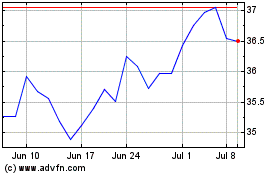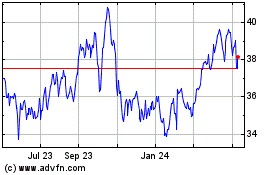Shell, BP Earnings Benefit From Cost Cuts Amid Weak Oil Prices
November 01 2016 - 8:08AM
Dow Jones News
By Sarah Kent and Selina Williams
LONDON-- Royal Dutch Shell PLC and BP PLC posted surprise
improvements in third-quarter profits, joining other big oil
companies in showing progress in efforts to adapt to a world of
cheaper crude as prices rebounded from lows hit at the start of the
year.
The industry has been hammered by a slump in oil prices over the
past two years, forcing companies to slash jobs and spending while
scrambling to bring down costs. The scars of the price decline were
still evident in many companies' third-quarter earnings, but so
were signs of adaptation.
Shell returned to profit, posting the equivalent of $1.4 billion
net income in the third quarter of 2016, after reporting a net loss
of $6.1 billion a year earlier. BP's net earnings of $1.7 billion
were up from $1.2 billion a year earlier.
"We continue to make good progress in adapting to the
challenging price and margin environment," said BP Chief Financial
Officer Brian Gilvary.
The European companies' results were a positive signal in a
mixed season of earnings. French oil giant Total SA last week said
its third-quarter profit almost doubled from a year earlier to
nearly $2 billion, a gain the company's chief executive, Patrick
Pouyanne, attributed to deep cost cuts.
In the U.S., Exxon Mobil Corp. and Chevron Corp. last week said
their profit fell in the third quarter compared with a year
earlier, illustrating how the efforts to manage the price downturn
are still work in progress.
Most big oil companies are continuing to work to bring down
their costs in an uncertain price environment. Shell said next year
it expects to spend $25 billion on finding and developing new oil
and gas projects, at the lower end of a spending range it disclosed
this year to investors. BP said it planned $1 billion less in
capital spending in 2016, at $16 billion, than previously forecast.
Exxon slashed its capital and exploration spending 45% in the third
quarter from a year ago.
The cost cuts mean many big oil companies are close to
generating enough cash to cover the investment budgets and dividend
payments at the current oil price level, a crucial inflection point
for investors anxious about the safety of their dividends.
Oil prices were generally lower in the third quarter of 2016
compared with the same time in 2015, averaging $45.86 a barrel for
Brent crude, the international benchmark. The prices are down over
50% from the heights of $100 a barrel or more they traded at for
much of 2011 to 2014. A global oversupply of oil has kept the
market depressed.
BP and Shell's earnings were a respite after more than two years
of ugly numbers. The figures underscore growing optimism among many
industry executives that the worst of the price rout is coming to
an end as supply and demand come back into balance.
But that recovery could still be on a knife edge as members of
the Organization of the Petroleum Exporting Countries are
struggling to hammer out a final plan for a modest output cut
before a Nov. 30 meeting in Vienna. Their failure to agree is
keeping a lid on oil prices that staged a modest recovery last
month and optimism within the industry remains cautious.
The companies themselves remain cautious on their investment
plans, anxious to stress efforts to focus on increasing value
rather than returning to profligate spending.
"We're planning next year on $50 a barrel. We're planning the
balance sheet for potentially even lower than that, and were
building the portfolio to be robust at anything above $50 a
barrel," Shell CFO Simon Henry said.
Write to Sarah Kent at sarah.kent@wsj.com and Selina Williams at
selina.williams@wsj.com
(END) Dow Jones Newswires
November 01, 2016 07:53 ET (11:53 GMT)
Copyright (c) 2016 Dow Jones & Company, Inc.
BP (NYSE:BP)
Historical Stock Chart
From Mar 2024 to Apr 2024

BP (NYSE:BP)
Historical Stock Chart
From Apr 2023 to Apr 2024
